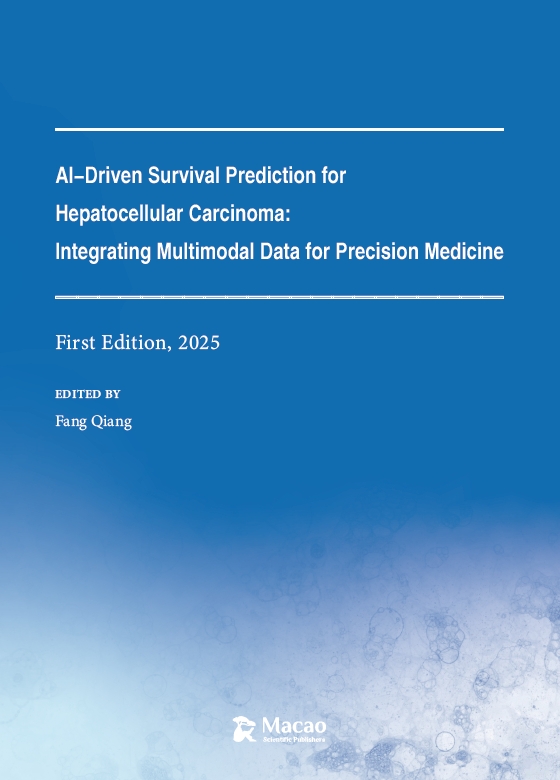Published:March 2025;
Format:Hardback, 1/16;
Pages:219;
Number of words:307,951
Copyright: © 2025 Authors & MOSP; Copyright Inquiry: book@mospbs.com
ISBN: 978-99981-10-03-8
Keywords: Nutritional; Tea Polyphenols; Health
*Correspondence: Zhejiang Ocean University College Zhejiang,China: None.
·Preface·
This book will delve deeply into how artificial intelligence (AI), particularly large language models (LLMs) and deep learning techniques, can be applied to improve survival prediction for hepatocellular carcinoma (HCC) patients.
It will cover everything from theoretical foundations and technical methodologies to practical implementations and clinical integration. The focus will be on CNLC IIIA HCC patients undergoing radiotherapy and targeted immunotherapy, with
extensive examples and case studies based on your provided insights and data.
·Content·
Chapter 1: AI-Driven Survival Prediction for Hepatocellular Carcinoma: Integrating Multimodal Data for Precision Medicine
Chapter 2: Fundamental Concepts of Artificial Intelligence
Chapter 3: Fundamentals of Large Language Models
Chapter 4: Epidemiology and Clinical Characteristics of HCC
Chapter 5: Multi-modeling with deep learning for disease prediction
Chapter 6: Two Optimizing Disease Modifying Therapy (DMT) Selection in Relapsing-Remitting Multiple Sclerosis Using Deep Learning
Chapter 7: Dataset and NLP Model
Chapter 8: The Evolution of Language Models
Chapter 9: Training and Deployment of Large Language Models
Chapter 10: Optimizing Disease Modifying Therapy (DMT) Selection in Relapsing-Remitting Multiple Sclerosis Using Deep Learning
Chapter 11: Hypothesis and Solution for Research Proposal
Chapter 12: NLP Application
Chapter 13: Dataset and NLP Model
Chapter 14: Comprehensive Analysis of the NEMESIS Method
Chapter 15: Experimental Validation and Performance Analysis
Chapter 16: Dynamic Spatiotemporal Registration for Multimodal Imaging in Hepatocellular Carcinoma Prognosis
Chapter 17: Registration in Detailed Steps
Chapter 18: Modern Treatment Strategies for Hepatocellular Carcinoma (HCC)
Chapter 19: Integrative Multi-Omic Feature Extraction and Dimension Reduction Techniques for Predicting Breast Cancer Aggressiveness
Chapter 20: Modern Treatment Strategies for HCC
Chapter 21: Survival Prediction in HCC
Chapter 22: Overview of AI in Oncology
Chapter 23: Using Large Language Models for Clinical Text Analysis
Chapter 24: Imaging Data Analysis for HCC Survival Prediction
Chapter 25: Advantages of Using Large Language Models and Multimodal Approaches Over Cox Survival Analysis for Predicting Liver Cancer Survival
Chapter 26: Cross-Aligned Multimodal Representation Learning (CAMR) for Cancer Survival Prediction
Chapter 27: LLM-Guided Multi-modal Multiple Instance Learning for 5-Year Overall Survival Prediction of Lung Cancer
Chapter 28: Segment Anything
Chapter 29: Multimodal Data Fusion: Framework and Architectures
Chapter 30: AI-Driven Survival Prediction for Hepatocellular Carcinoma: Integrating Multimodal Data for Precision Medicine
Chapter 31: AI-Driven Survival Prediction for Hepatocellular Carcinoma: Integrating Multimodal Data for Precision Medicine
Chapter 32: Hepatocellular Carcinoma (HCC) analysis
Chapter 33: End-to-End Multimodal Fusion for Survival Prediction in HCC
Chapter 34: Cutting-Edge Approaches, Persistent Challenges, and Horizons for Multimodal Fusion
Chapter 35: Precision Therapy and Multimodal Radiomics in Primary Hepatocellular Carcinoma (HCC)
Chapter 36: Building and Implementing a Multimodal Large Model-Based Survival Prediction System for Hepatocellular Carcinoma
Chapter 37: Time-Series Modeling for Outcome Prediction in Liver Cancer Radiotherapy
Chapter 38: Hierarchical Spatiotemporal Fusion Architecture for Survival Prediction in Radiotherapy
Chapter 39: Multimodal Target Volume Contouring Framework for Radiation Oncology
Chapter 40: The Future of AI: Ten Key Trends Shaping 2025 and Beyond
Reference
·About the Authors·
Mr. Fang Qiang is Professor of Marine Engineering Equipment at Zhejiang Ocean University College.
·Copyright Information·
Nutritional Research and Health Benefits of Tea Polyphenols
Hardcover, Word Count: 307,951 words
First Edition: March 2025
Published by Macao Scientific Publishers (MOSP)
Printed by HanLin Publishing Group, Macao, China
ISBN: 978-99981-10-03-8
·Retrieval·
Macao Scientific Publishers
Address: Block 11/F, Hengchang Building, Nanwan Avenue, Macao, 999078, China
For more information, contact book@mospbs.com
This publication is safeguarded by copyright. Unless otherwise specified under statutory exceptions or in accordance with the provisions stipulated within pertinent collective licensing agreements, any reproduction of any segment of this publication is strictly prohibited without obtaining the written authorization from Macao Scientific Company.
For detailed information regarding the publishing process at Macao Scientific Publishers, kindly visit our official website https://www.mospbs.com/
Copyright © Macao Scientific Publishers. All rights reserved.


